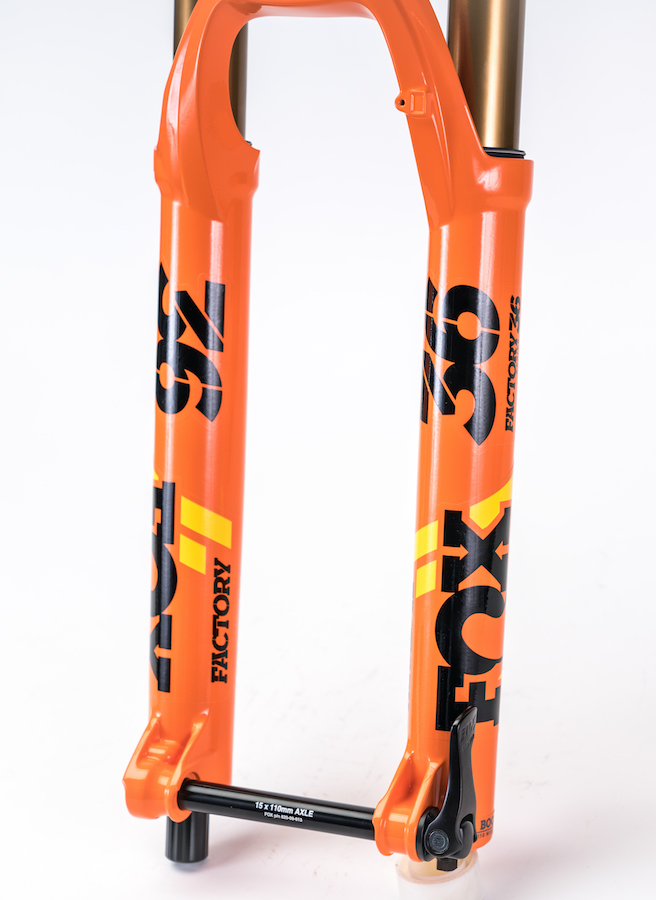Fox 36 Factory FIT GRIP2
Originally posted on January 21, 2019 at 4:20 amFox 36 Float Factory GRIP2 – $1,065
By Eric McKeegan
This review is about this bright orange 2019 Fox 36 fork shown above. But in reality, this review is really about the new GRIP2 damper that replaces the RC2 damper in the all-mountain 36 and downhill 40 forks.
This damper is an example of trickle-up evolution. The original GRIP damper is a basic design found in Fox’s lower-end, original equipment forks. It uses a self-bleeding closed system with a basic coil-spring-backed internal floating piston. It was designed to hit a price point and only offers basic low-speed rebound and compression damping adjustments.
The thing is, this basic damper works really, really well. Even spoiled mountain bike journalists like myself admitted this basic fork rivaled the performance of the most expensive forks on the market.
Rather than ignore this fact, Fox redesigned the high-end damper found in its downhill and all-mountain forks using a similar design, creating GRIP2. Unlike the GRIP damper, GRIP2 has adjustments for high- and low-speed damping for both compression and rebound.

That high-speed rebound adjustment is new for Fox, and is the result of entirely new damping architecture, new enough to result in application for patents. The new damper is also simpler, requiring less seals, which means less friction. Oil volume is increased as well, which should help keep temperatures down on long descents and increase service intervals.
While I’ve got quite a few miles on the orange fork pictured, I’ve also managed a lot of rides in a lot of places on a lot of bikes on other 36 forks with this new damper. And the damper is the story here. A Pivot Firebird 29 in Moab, a new Trek in Mammoth, an Alchemy Arktos and Ibis Ripmo in Crested Butte and a Santa Cruz Bronson in Pisgah. Not only does this reveal me to be a lucky SOB, it also shows that there are some product managers as much in love with this fork as I am.
Yes, it requires more setup than Fox’s simpler FIT4 damper option, but once you get the GRIP2 dialed in, it leaves almost nothing to complain about. The recommended air spring and damper setting will get most riders within a few psi or clicks of happy.
By happy I mean not thinking much at all about the fork. With this new damper, Fox has created an even plusher fork than before, but with seemingly telepathic control of the mid-stroke, and with the right combo of pressure and volume spacers, it’s almost impossible to bottom harshly. The high-speed rebound allows for more control over hard impacts like cased jumps and g-outs while keeping the fork moving enough at lower speeds to remain active.

Modern rear suspension designs have a lot of options to get the suspension feeling just right, but suspension forks are much more limited: no linkages to change leverage ratios, no anti-squat to control unwanted movement. That leaves the damper to do a lot of work to keep pace, something the GRIP2 has no issues doing, on all kinds of bikes and all kinds of terrain.
It might take half a dozen rides to be truly satisfied that the suspension settings are correct on this fork, but after that, a click or three of low-speed compression to tune for steepness or pedaling are all it takes to feel dialed.
I’ve been lucky enough to ride a lot of Fox 36s over the last few years, and I appreciate the way new technology is rolled out on a regular basis, rather than one big redesign every few years. Since the chassis of this fork has remained the same for a few years, the GRIP2 damper can be easily dropped into an older fork.
The 36 is as good as it gets these days. If you aren’t interested in messing with a fork to get it perfect, the GRIP damper might be a better choice. But for all-mountain riders looking to get everything dialed in perfectly, you don’t need to shop around; you are looking at the fork for you.
ridefox.com